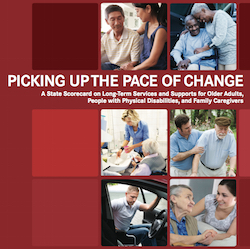
States will need to accelerate the rate of improving long-term services and supports in several areas to meet the upcoming needs of aging baby boomers, according to a report released today by the AARP.
Among the areas for improvement identified in “Picking Up the Pace of Change: A State Scorecard on Long-Term Services and Supports for Older Adults, People with Physical Disabilities and Family Caregivers,” funded by the AARP Foundation, the Commonwealth Fund and the SCAN Foundation:
- Residential care options for those for whom living at home no longer is a viable option.
- Medicaid and state-only funding for home- and community-based services, because, on average, funding can pay for three people receiving home- and community-based care for the cost of one person living in a nursing home.
- Subsidies for affordable housing for lower-income individuals.
- Low-income rental units, especially for people with LTSS needs, who typically have lower incomes and higher costs for healthcare and supportive services.
About 52% of people turning 65 today will at some point develop a severe disability that will require LTSS, according to the AARP, and baby boomers will begin turning 80 in 2026. Without changes, states won’t be ready, according to the report.
The scorecard ranks states based on their LTSS-related performance on 25 indicators in five main categories: affordability and access; choice of setting and provider; quality of life and quality of care; support for family caregivers; and effective transitions between nursing homes, hospitals and homes.
“Where you live matters, and it matters because consumers’ experiences of LTSS vary a great deal depending on where you live,” Susan Reinhard, RN, Ph.D., senior vice president and director of the AARP Public Policy Institute, said in a call with members of the press on Tuesday.
The report lists the top-ranking states overall as Washington (No. 1), Minnesota, Vermont, Oregon and Alaska, and the bottom-ranking states as Indiana (No. 51), Kentucky, Alabama, Mississippi and Tennessee, but the overall rankings don’t tell the whole story, Reinhard said.
Top and bottom states for assisted living supply
Among the indicators, for instance, was the number of assisted living and residential care units per 1,000 people aged 75 or more years. The research found that the number of assisted living units ranged greatly, from a high of 121 units per 1,000 older adults in Oregon to a low of 20 units in Louisiana.
In the top quartile for assisted living supply (in order of states’ overall rankings): Minnesota, Washington, Oregon, Alaska, Wisconsin, Idaho, Montana, Iowa, Connecticut, Kansas, Nebraska, Pennsylvania, North Dakota, North Carolina and South Dakota.
In the bottom quartile for assisted living supply (in order of states’ overall rankings): Massachusetts, New Mexico, New York, District of Columbia, Louisiana, Arkansas, Delaware, West Virginia, Wyoming, Nevada and Alabama.
States that had improved from the 2014 to 2017 scorecards as to the number of assisted living and residential care units per 1,000 people aged 75 or more years included (in alphabetical order) Arkansas, New York, Ohio, Oklahoma, Rhode Island, Wisconsin and Wyoming.
States that declined in performance on this indicator included (in alphabetical order) Alabama, Alaska, California, Georgia, New Jersey, North Carolina and South Carolina.
Thirty-two states saw no significant change in performance on this indicator, and data for both years were not available for five states.
Healthcare reform proposals ‘of great concern’
If you want to know where assisted living and LTSS in general are valued, Reinhard suggested, look at a state’s support for low-income older adults and people with disabilities. These states, Reinhard said, “have a certain culture that says, ‘This is important. We have to take care of those individuals.’ And it leads to infrastructure changes. It says, ‘We’re going to make sure you have alternatives to nursing homes, that you have assisted living, adult foster care, other options available to you.’ ”
That finding means that current legislative discussions related to healthcare reform are worrisome, she said.
“States that have the strongest Medicaid policies do better in a lot of other indicators, including family caregiving, and therefore, the current climate of Medicaid that we see — proposals that would cap Medicaid or would reduce the ability to have LTSS for people at the state level — is of great concern for us,” Reinhard said. “The progress that we’re making it at risk. There could be significant threats for consumers, millions of whom could lose very valuable, life-saving support.”
And it’s not just low-income older adults who are at risk, she said; it’s also middle-income older adults.
“Once you need LTSS and start paying out of pocket, you are at high risk for needing Medicaid,” Reinhard said. “Sixty percent of Medicaid spending right now is going to older adults and people with disabilities. So this is a very vulnerable population.”



